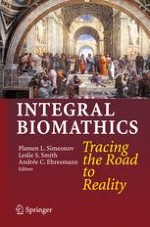2012 | OriginalPaper | Buchkapitel
The Engine of Engines – Toward a Computational Ecology
Aktivieren Sie unsere intelligente Suche, um passende Fachinhalte oder Patente zu finden.
Wählen Sie Textabschnitte aus um mit Künstlicher Intelligenz passenden Patente zu finden. powered by
Markieren Sie Textabschnitte, um KI-gestützt weitere passende Inhalte zu finden. powered by
Our knowledge related to the entailments of functionalities of different biological processes as they enable sentience to arise in the human is still limited due to the biological complexity of the body. There are two interrelated research paradigms that can be developed to approach this problem– one paradigm seeks to study the body and articulate its entailments (intra-functionalities) at multiple scales over time; the second paradigm seeks to glean knowledge from this study of biological processes and create new forms of computation to enable us to transcend the limitations of current computational modes. The nature and scope of the question necessitates an transdisciplinary approach to research through the development of a multi-perspective approach to knowledge production. Here, key solutions can in part arise at the interstices between disciplines, and potentially enable us to define and ‘chip away’ at the problem set. Central is observing the body as a distributed network of computational processes that function at different physical scales as well as across time-dependent, process-oriented accretive frames. We can articulate the study of the body by calling it an electrochemical computer— a computer whose deep functionality is not yet fully entailed. Historically the nature of the problem has been to isolate a biological system and study its entailments to ascertain its functionality. Yet, the nature of sentience asks us as researchers to take a more holistic approach, despite the complexity at play. These two paradigms then become a long-term problem set that a network of high-end researchers can collaborate on, by bringing different areas of expertise to the table. The notion of developing a biomimetic/bio-relational
Engine of Engines— A Computational Ecology
(Stengers 2005) derives from observing computational systems at work in the body and approaching them through observation— through technological, mathematical and/or computational abstraction. Where the body has been described as functioning as a computational system that transcends the Turing limit (Siegelmann 1999)(Maclennan 2003)(Penrose 1989) new approaches to computation need to be undertaken to reflect this deep complexity.
